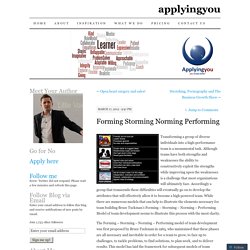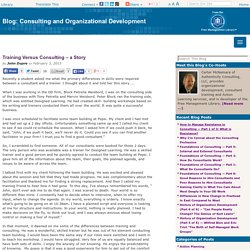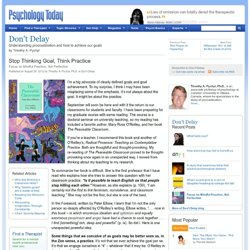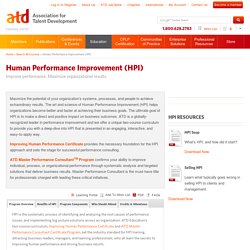

Crager.Simmons.Screencast_HPI.July.27.2015 - YouTube. Transforming a group of diverse individuals into a high-performance team is a monumental task.

Although teams have both strengths and weaknesses the ability to constructively exploit the strengths while improving upon the weaknesses is a challenge that most organizations will ultimately face. Accordingly a group that transcends these difficulties will eventually go on to develop the attributes that will effectively allow it to become a high powered team. While there are numerous models that can help to illustrate the elements necessary for team building Bruce Tuckman’s Forming – Storming – Norming – Performing Model of team development seems to illustrate this process with the most clarity. Forming In the first stage of Tuckman’s model a team is selected and the team leader takes an active role in outlining and defining the team’s objectives.
Storming In the storming stage there is an active role on the part of management in delegating duties and responsibilities. Norming Performing. Consulting and Organizational Development. Recently a student asked me what the primary differences in skills were required between a consultant and a trainer.

I thought about it and told her this story….. When I was working in the OD firm, Block Petrella Weisbord, I was on the consulting side of the business with Tony Petrella and Marvin Weisbord. Peter Block ran the training side, which was entitled Designed Learning. He had created skill- building workshops based on his writing and trainers conducted them all over the world. It was quite a successful business. I was once scheduled to facilitate some team building at Pepsi. So, I scrambled to find someone. I talked first with my client following the team building. In that moment, it dawned on me some of the differences between training and consulting. For more resources, see the Library’s topics: John Dupre is an organization development consultant who designs innovative ways to involve people in building more productive and satisfying workplaces.
Focus on learning mastery (how you are learning to do) vs. achievment. Learning Goals Or Performance Goals. Stop Thinking Goal, Think Practice. I’m a big advocate of clearly defined goals and goal achievement.

To my surprise, I think I may have been misplacing some of the emphasis. It’s not always about the goal. It might be about the practice. September will soon be here and with it the return to our classrooms for students and faculty. I have been preparing for my graduate course with some reading. If you’re a teacher, I recommend this book and another of O’Reilley’s, . To summarize her book is difficult. In the Foreword, written by Peter Elbow, I learn that I’m not the only person so deeply affected by O’Reilley’s writing. It’s not that we ever achieve the goal per se. ISPI (@ISPI1962) ISPI (@ISPI1962) Human Performance Improvement (HPI) Programs - ATD. Mason Holloway has an extensive professional background, including 15 years in senior management and consultative positions working in business consulting, business operations, sales, and human performance improvement (HPI).

He is a senior analyst, performance technologist, and experienced practitioner of the HPI processes. He has demonstrated skills and expertise in assisting companies in meeting and exceeding aggressive and competitive organizational goals and improving overall business results through HPI processes. Holloway's clients have included The U.S. Navy, National Technical Information Service, L.L. Bean, Social Security Administration, Accelera Corporation, ServiceMaster, and Microsoft.
Most recently, working with partner Dennis Mankin, Holloway led the design and development team in the creation of Performance DNA, the most comprehensive and effective tool set for analyzing human performance. Facilitates the following: The Engagement Effect: Human Performance Improvement. What is Human Performance Improvement?

The Human Performance Improvement process is very similar to Human Performance Technology. HPI provides you with a systematic process to follow on what can often be a not-so-systematic path. In addition to identifying human performance gaps and their possible solutions, this standardized approach offers the ability to measure the success of your efforts and eliminate the guesswork that follows when a performance gap must be evaluated. HPI is results-based and systematic. Rather than focusing on a ‘wants-based’ or ‘needs-based’ approach, HPI follows a ‘results-based’ approach to improving performance, distinguishing it from many HRD (human resource development) activities.